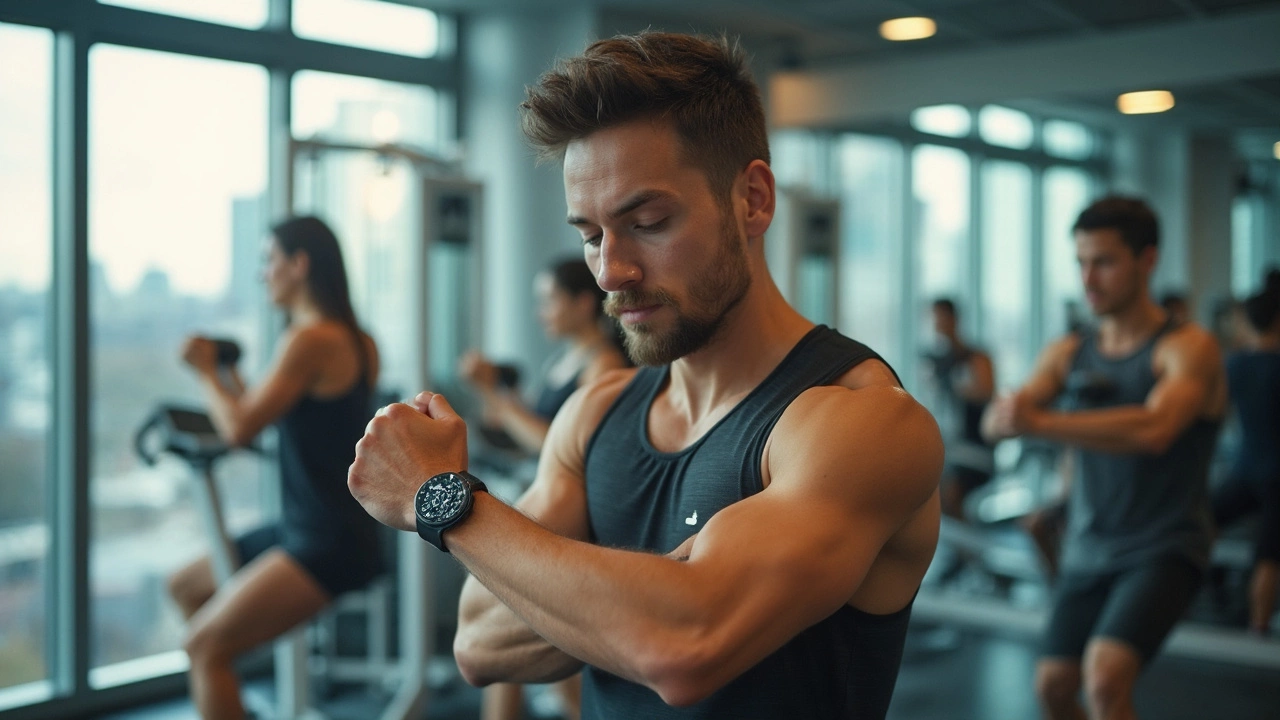
Gym Workouts June 11, 2025
Is 30 Minutes at the Gym Enough? Your Workout Time Demystified
Most people think you need to spend hours in the gym to see real results. Here’s the twist: research from the American College of Sports Medicine says even 20 minutes of focused training, done right, can lead to noticeable fitness gains. The key? Work smarter, not longer.
It all depends on how you use your time. You can stroll on the treadmill for 30 minutes and barely burn a cookie, or you can smash out a circuit of squats, push-ups, and kettlebell swings and leave drenched in sweat. Technique, intensity, and rest periods matter way more than how long you stick around.
If you’re busy, or just not the type who loves spending half your evening at the gym, you’re not alone. A lot of trainers now design killer 30-minute workouts for people who want max results in minimum time. Sound like you? Keep reading for clear tips and easy tweaks to make your short gym visits count.
- The Truth About Short Gym Sessions
- What 30 Minutes Can Do for Your Body
- Common Mistakes that Waste Time
- How to Maximize Every Minute
- Who Benefits (and Who Doesn’t) from Quick Workouts
The Truth About Short Gym Sessions
If you’re worried 30 minutes isn’t enough to hit your goals, here’s the real story. A ton of studies show you don’t need to sweat for 90 minutes to see results. For example, a 2012 trial from the University of Copenhagen tracked two groups—one did 30-minute workouts, the other 60. Both dropped weight, but the shorter workout crew actually lost just as much fat as the longer group.
It’s all about being efficient. You can build muscle, burn fat, and boost your heart health in a quick session, as long as your workout is dialed in. High-intensity workouts, circuits, or even fast-paced strength training work wonders in less time. Fitness isn’t measured by how long you’re in the gym, but by what you do while you’re there.
- Short workouts are easier to stick to and less likely to burn you out.
- You can improve your fitness noticeably with just 3–4 gym sessions a week, at 30 minutes each.
- Recovery is easier, letting you show up fresh and ready for your next workout.
Let’s look at what research says about gym workouts using focused, short sessions:
| Workout Type | Length | Main Benefit |
|---|---|---|
| HIIT | 15–30 minutes | Bigger calorie burn, improved endurance |
| Strength Circuit | 20–35 minutes | Muscle gain, fat loss |
| Moderate Cardio | 25–35 minutes | Better heart health |
Now, not all short sessions are created equal. You need to set a plan, avoid mindless rest, and go in with purpose. Do that, and you’ll see you don’t need marathon workouts to get strong, lean, and fit.
What 30 Minutes Can Do for Your Body
You’d be surprised how much you can actually accomplish in just half an hour at the gym. The idea that quick gym workouts aren’t effective is outdated. In reality, short sessions—done right—boost strength, fire up your metabolism, and improve how you feel day-to-day.
Let’s get specific. The Centers for Disease Control and Prevention (CDC) points out that just 150 minutes of moderate-intensity exercise a week keeps your heart healthy, cuts your risk of chronic disease, and helps you maintain a healthy weight. That’s only five 30-minute sessions. And if you go for high-intensity, you can often halve that time.
| Activity | Calories Burned in 30 min* (moderate effort) |
|---|---|
| Running (6 mph) | 372 |
| Stationary cycling | 315 |
| Circuit training | 240 |
| Bodyweight exercises | 180 |
*Calories based on a 155-lb (70 kg) adult
Let’s talk muscles. Scientists at McMaster University found that resistance training—think squats, deadlifts, bench press—done for about 30 minutes, 2-3 times a week, bumps up muscle strength and lean mass even in people over 60. You don’t need hours under the barbell for progress.
If fat loss is on your mind, focus on intensity and minimal rest. High-Intensity Interval Training (HIIT) has blown up for a reason: people doing 30-minute HIIT sessions have seen better fat loss in less time compared to longer steady-state cardio. Plus, intense workouts make your body keep burning calories even after you leave the gym.
- Try supersets—pair two exercises back to back with no rest. Works more muscles in the same time.
- Keep your phone away. No texting between sets means more work, less wasted time.
- Plan your workout before stepping foot in the gym. Winging it = time lost.
- Use compound moves (like squats, push-ups, rows). They hit many muscles at once and give you more bang for your buck.
The big takeaway? A 30-minute workout—if it’s focused and intense—can build muscle, shred fat, and boost your energy. It’s all about quality, not quantity.

Common Mistakes that Waste Time
You’d be surprised how easy it is to burn through 30 minutes at the gym and get almost nothing done. It’s not about being lazy; it’s about how you spend every minute. One of the biggest mistakes? Scrolling through your phone between sets. Studies say the average gym-goer wastes around 15 minutes per hour just checking messages or social feeds. That’s half of a half-hour session gone before you’ve even noticed.
Another classic blunder: long rest periods. Unless you’re training for powerlifting, you really don’t need three to five minutes between sets. For most gym workouts, 30 to 60 seconds will do. Sticking to shorter breaks keeps your heart rate up and lets you fit in more work fast.
Let’s talk about wandering. Some folks bounce randomly from one machine to another without a plan, wasting time waiting for equipment or figuring out what to do next. The fix? Come in with a goal, whether it’s a written workout or a note in your phone.
- Skipping warm-ups or doing them too long (five minutes tops is enough for most workouts)
- Doing slow, isolated exercises instead of compound moves that work several muscles at once
- Chatting with other gym-goers for extended periods
Just look at this table to see what gym-goers waste time on in a typical 30-minute session:
| Time-Waster | Average Time Lost |
|---|---|
| Phone use/social media | 7 minutes |
| Overly long rest periods | 6 minutes |
| Waiting for equipment | 5 minutes |
| Idle chatting | 4 minutes |
| Deciding what to do next | 3 minutes |
Total that up and you could lose 25 out of your 30 minutes without breaking much of a sweat. The takeaway? Stick to timed intervals, know your workout before you walk in, and leave the phone in your locker. It’s not about hustling non-stop, but making every move count if you’ve only got half an hour.
How to Maximize Every Minute
If you’re walking into the gym with just 30 minutes, every second counts. You can’t afford to waste time scrolling on your phone or waiting for a machine. Here’s how you pack the most punch into your quick workout:
- Plan before you step in: Don’t wander around deciding what to do. Write your workout in your notes app or on paper. Know your exercises, sets, and reps. This saves you at least five minutes of dawdling.
- Use compound movements: Go for exercises that hit several muscles at once. Think squats, deadlifts, push-ups, bench presses, and lunges. These burn more calories and build more muscle per minute than isolated exercises.
- Try supersets or circuits: Pair exercises back-to-back with little or no rest. For example, do a set of push-ups, then immediately hit squats. This keeps your heart rate up and your workout moving fast.
- Keep rest short and consistent: 30-60 seconds between sets is plenty for most people aiming for general fitness. Set a timer if you need to. This keeps you from drifting or chatting.
- Stay off your phone: Unless you’re using it for music or your workout plan, put it in airplane mode. A lot of people waste more time on social media than on lifting the actual weights.
High-intensity interval training (HIIT) is a game-changer for 30-minute sessions. One study from the Journal of Sports Science & Medicine found that HIIT can burn up to 30% more calories than moderate steady-state cardio in the same amount of time.
If you like seeing the numbers, here’s a quick breakdown of what you can squeeze into 30 minutes, compared to longer workouts:
| Workout Length | # of Exercises | Average Calories Burned | Workout Style |
|---|---|---|---|
| 30 Minutes (Full-Body Circuit) | 5-7 | 200-350 | HIIT/Supersets |
| 60 Minutes (Traditional Split) | 7-12 | 350-600 | Weights/Cardio Mix |
Notice that with a tight, focused routine, those 30 minutes can be super productive. The difference isn’t just about time—it’s about how you use it. If your goal is to squeeze every bit out of your gym workouts, structure is your best friend. Don’t just go through the motions—go in with intention, hit it hard, and get out with a sweat.

Who Benefits (and Who Doesn’t) from Quick Workouts
Not everyone responds the same way to quick gym sessions. The truth is, 30-minute workout plans work for some, while others need more time to chase their goals. Here’s the breakdown.
Short, sharp workouts are especially solid for these groups:
- Busy adults: If your schedule is packed, a half-hour session is way better than skipping the gym altogether. Research from Stanford found that people with time-crunched days actually stick to short routines more often—and consistency is king.
- Beginners: If you’re new to fitness, 30 minutes helps you build a solid habit without feeling overwhelmed. You won’t fry your muscles or burn out on day one.
- Anyone training for fat loss or basic strength: Intense, focused sessions with short rest periods can fire up your metabolism. One European study showed 27% more fat burned with interval training versus steady exercise, even in less time.
- People wanting to boost cardio health: Sprint intervals or HIIT (High Intensity Interval Training) in 30 minutes can improve heart health, according to work published by the American Heart Association.
But 30 minutes isn’t a magic bullet for everyone. Here’s where it falls short:
- Advanced lifters: If your goal is serious muscle size or powerlifting, you’ll need longer rest and extra volume—most pros spend at least 45–90 minutes per session.
- Athletes training for endurance sports: Marathon runners, cyclists, or triathletes can’t get all their mileage in half an hour. They need longer, steady sessions to build stamina.
- People after major body transformations: If you want extreme weight loss or a dramatic physique change, 30 minutes is a start, but you’ll need to pair it with activity outside the gym and extra training days.
| Group | Works Well? | Why |
|---|---|---|
| Beginners | Yes | Builds routine, not overwhelming |
| Busy professionals | Yes | Fits limited schedule |
| Advanced bodybuilders | No | Needs more time for muscle growth |
| Endurance athletes | No | Longer training required |
| Casual exercisers | Yes | Easy to maintain |
The bottom line? Quick workouts work wonders if they match your fitness goals and skill level. If you’re looking for simple ways to get healthier or stay strong, 30 minutes can be all you need. Chasing trophies or dramatic changes? You might want to stretch that gym time a bit longer.




